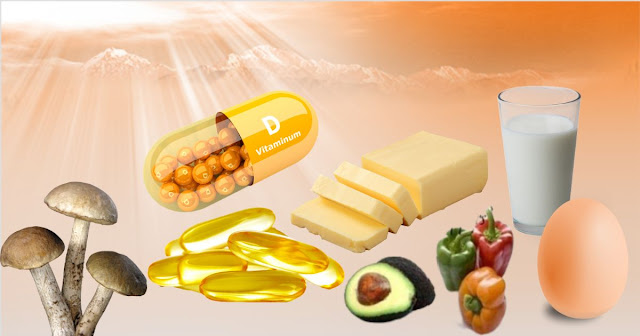 |
| Vitamin D Health Benefits Deficiency Toxicity |
Vitamins are a type of organic nutrient that helps in the nutrition and growth of the body. In 1911, the vitamin was discovered by the scientist Cashmere Funk.
In simple words, the special organic nutrients that help in normal nutrition and growth of the body in very small amounts in normal food and increase immunity are known as vitamins.
Every vitamin we get from natural foods or other elements and there are some essential vitamins, such as - Vitamin A, Vitamin B Complex, Vitamin C, Vitamin D Compounds, Vitamin E, Vitamin K, and Vitamin P.
According to solubility, these all vitamins are divided into two groups, such as:
- Water-soluble vitamins (Vitamin B, Vitamin C, and Vitamin P)
- Fat-soluble vitamins ( Vitamin A, Vitamin D, Vitamin E, Vitamin K).
In this post, we have covered a few questions about vitamin D including "What is vitamin D good for for". To describe deeply about vitamin D, let's start with the basic question:
What is vitamin D?
 |
| Vitamin D |
Vitamin D is a very important vitamin, it is also known as an essential nutrient to our body. Vitamin D is a group of prohormones. Which helps the body absorb iron, zinc, magnesium, calcium, and phosphate.
Vitamin D is produced in the body by exposure to sunlight and it is also found naturally in foods.
The natural source of the D vitamin is sunlight. Vitamin D is produced by the synthesis of cholecalciferol in the lower layers of the skin's epidermis through a chemical reaction in the presence of sunlight, a process particularly accomplished by ultraviolet radiation.
Why is vitamin D necessary?
Vitamin D is needed for healthy teeth, bones, and muscles. Various studies have shown that a lack of vitamin D can cause bones to not develop properly and children may suffer from a disease called rickets and adults may suffer from a weak bone disease called osteomalacia.
What is vitamin D good for?
1. Vitamin D helps to keep away the problem of our eyesight getting weaker as we age.
2. Vitamin D with the help of calcium prevents muscle problems. Sometimes we feel the tension in the muscles in our body which is not a good sign, remember that these can cause problems like rickets.
3. Helps to reduce bad cholesterol in the body. It also helps in reducing heart problems.
4. Vitamin D is quite beneficial for chronic headaches and weight loss, especially in women.
What Foods are Good for Vitamin D?
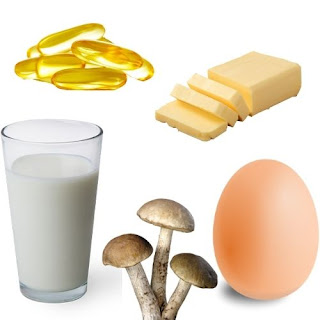 |
| Foods are Good for Vitamin D |
- Fish oil
- Dried mushrooms
- The egg
- The milk
- Butter etc.
What are the types of Vitamin D?
There are two types of vitamin D.
- Vitamin D2 (made from plants is called ergocalciferol.)
- Vitamin D3 (well known as cholecalciferol is produced in the skin by exposure to sunlight.)
These D3 and D3 are the most important compounds of the secosteroid group in the human body.
What is the difference between d2 and d3?
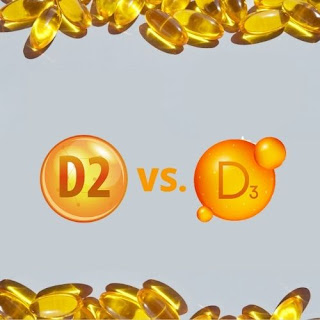 |
| Difference Between D2 and D3 |
D2 and D3 vitamins are the two main forms of vitamin D. There has no big difference between them without some basics, for example, sources and some responsibility.
What is vitamin D2 good for?
Vitamin D2 is a plant-based vitamin derived from plant sources but is also found in some types of mushrooms.
In the human body, vitamin D2 helps to maintain the proper balance of calcium and phosphate. It also helps to use and absorb phosphate and calcium in our body, which are important building blocks for bone and many other body processes, especially the nervous system.
This D2 vitamin is mostly indicated in the treatment of most parathyroid diseases and calcium disorders. Patients with chronic kidney disease require vitamin D2, which is also the preferred form.
What is the source of Vitamin D2?
It’s the most common form in fortified foods because it is cheaper to produce. Some most common sources of D2 vitamins are:
- Mushrooms (grown in UV light)
- Fortified foods
- Dietary supplements
What is vitamin d3 good for?
Vitamin D3 basically comes from animal sources or exposure to sunlight. This sunlight-derived vitamin is also known as cholecalciferol.
It is one of the most important nutrients among other vitamins. The most important function of vitamin D3 is to help the absorption of calcium and phosphorus from the digestive system.
Its antihypertensive properties also help regulate blood pressure. Vitamin D3 protects the heart thereby reducing the risk of heart disease.
Vitamin D3 boosts the immune system and protects the body from bacterial infections. It has antitumor and anticancer effects thereby reducing the risk of cancer by inhibiting the growth of tumor cells.
It also helps in controlling blood sugar problems thereby reducing the risk of diabetes. It is essential for normal cell and bone growth and overall good health.
What is the source of Vitamin D3?
Sunlight is a great and important source of vitamin D3. Vitamin D-3 is also available in various animal foods such as:
- Cod liver oil,
- Egg yolk,
- Liver,
- Mushrooms,
- Salmon fish,
What vitamin Is better to take vitamin D2 or D3?
Research has repeatedly shown that vitamin D3 is superior to vitamin D2 at raising the level of vitamin D in the body. Also, these results were supported by a recent review of the evidence which found that D3 vitamin supplementation increased vitamin D levels in the body better than D2 vitamin.
Table-1: Vitamin D Rich Foods Table.
|
Food |
Micrograms (mcg) per serving |
International Units (IU) per
serving |
Percent DV |
|
Cod Liver Oil, 1
Table Spoon |
34.0 |
1360 |
170 |
|
Trout (rainbow),
farmed, Cooked, 3 ounces |
16.2 |
645 |
81 |
|
Mushrooms, White
Raw, Sliced, Exposed to UV light half cup |
9.2 |
366 |
46 |
|
Milk, 2% milk
fat, Vitamin D fortified, 1 cup |
2.9 |
120 |
15 |
|
Almond, Oat Milks, and Soy, Vitamin D fortified, Various brands, 1 cup |
2.5
- 3.6 |
100
- 144 |
13
- 18 |
|
Ready to eat cereal,
fortified with 10% of the DV for vitamin D, 1 serving |
2.0 |
80 |
10 |
|
Sardines,
Canned in oil Drained, 2 Sardines |
1.2 |
46 |
6 |
|
Egg, 1 large, Scrambled** |
1.1 |
44 |
6 |
|
Liver, Beef,
Braised, 3ounces |
1.0 |
41 |
5 |
|
Light Tuna Fish,
Canned in water, Drained, 3 ounces |
1.0 |
40 |
5 |
|
Cheese, Cheddar,
1.5 ounce |
0.4 |
17 |
2 |
|
Mushrooms,
Portabella, raw, diced, half cup |
0.1 |
4 |
1 |
|
Chicken breast,
roasted, 3 ounces |
0.1 |
4 |
1 |
|
Beef, ground 90%
lean, broiled, 3 ounces |
0 |
1.7 |
0 |
Deficiency of Vitamin D.
 |
| Causes Vitamin D Deficiency |
"What is the deficiency of vitamin D?" if you ask, then it has a simple answer, this is the opposite of the necessity of vitamin D. It means if your body feels a deficiency of vitamin D compound, wellness will leave from your body. A low amount of vitamin D in the blood causes the following diseases.
- Cancer.
- Deterioration of the brain in the elderly.
- Asthma in children.
- More likely to die from cardiovascular disease.
- Bone disease.
- Rickets.
- Infertility.
What causes Vitamin D deficiency?
- Obesity can lead to vitamin D deficiency. Obesity slows down blood flow in the body.
- People with a BMI of more than 30 are more likely to be vitamin D deficient.
- Lack of exposure to the sun causes vitamin D deficiency in the body.
- If a person's digestive system does not absorb vitamin D properly, it increases the risk of many diseases.
- Vegetarian foods are not high in vitamin D. Non-vegetarian foods are high in vitamin D.
- Without eating vitamin D foods, the body becomes deficient in vitamin D.
What are the symptoms of Vitamin D deficiency?
- Frequent shortness of breath.
- Getting very sick
- Depression
- Sweat on the brain
- Having health problems.
- Excessive sleep
- Bone pain
- Muscle weakness.
- Tiredness despite not doing any work.
What is the treatment for Vitamin-D deficiency?
To prevent vitamin D deficiency, doctors recommend eating vitamin D-rich foods and sometimes vitamin D supplements.
How much vitamin D should be taken? This is decided by the doctor based on the individual's symptoms. For example, feeling weak and more tired, poor digestion, old age, etc. So take the doctor's advice and do not take vitamin D medicine without the doctor's advice.
If the person is mildly deficient in vitamin D, the doctor makes some general recommendations. Such as:
- Do yoga regularly.
- Practice walking in the sun every morning.
- Taking vitamin D supplements.
- Eating foods rich in calcium.
How to cure Vitamin D deficiency?
- Get Sun Rays to increase Vitamin D, these rays are absorbed by the skin and increase vitamin D in the body. Consume foods rich in vitamin D, such as salmon, mackerel, yogurt, fish liver, etc.
- There are other foods rich in vitamin D. Such as – Eggs, Cheese, Mushrooms, Milk, Mate, etc.
- Some liquid sources of vitamin D are as follows: – Orange juice, Cereals, Milk products, Soy milk, etc.
- Daily exercise and sunlight should be taken to keep the body in balance.
- If vitamin D is deficient due to any disease, consult a doctor to increase vitamin D.
How much vitamin D is too much?
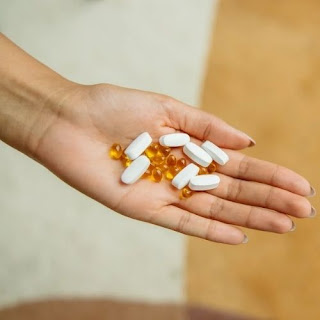 |
| How Much Vitamin D is too Much |
The RDAs for vitamin D are listed in both micrograms(mcg) and international units (IU), where 1 mcg of vitamin D is equal to 40 IU.
Although sunlight is a major source of vitamin D for some people, the FNB based the vitamin D RDA on assumption that people get minimal sun exposure.
For children, the FNB committee developed AIs based on the amount of vitamin D that maintains serum 25(OH)D levels above 20 ng/mL (50 nmol/L) and supports bone development.
Table-2: According to the National Institutes of Health Recommended Dietary Allowances (RDAs) for Vitamin.
|
Age |
Male |
Female |
Pregnancy |
Lactation |
|
0-12 months* |
10
mcg(400 IU) |
10
mcg(400 IU) |
|
|
|
1–13 years |
15
mcg(600 IU) |
15
mcg(600 IU) |
|
|
|
14–18 years |
15
mcg(600 IU) |
15
mcg(600 IU) |
15
mcg(600 IU) |
15
mcg(600 IU) |
|
19–50 years |
15
mcg(600 IU) |
15
mcg(600 IU) |
15
mcg(600 IU) |
15
mcg(600 IU) |
|
51–70 years |
15
mcg(600 IU |
15
mcg(600 IU) |
|
|
|
>70 years |
20
mcg(800 IU |
20
mcg(800 IU) |
|
|
Many other countries around the world and some professional societies have slightly different guidelines for vitamin D intake.
These differences are the result of an incomplete understanding of the biology and clinical effects of vitamin D, use in some guidelines of randomized clinical trials, as well as observational studies to establish different purposes and/or recommendations for guidelines.
For example, to maintain serum 25(OH)D levels above 75 nmol/L (30 ng/mL), adults may need at least 37.5 to 50 mcg (1,500-2,000 IU)/day of supplemental vitamin D, says the Endocrine Society and children and adolescents may need at least 25 mcg (1,000 IU)/day.
In contrast, for the citizens of the UK aged 4 years and older the United Kingdom government recommends an intake of 10 mcg (400 IU)/day.
What is the Toxicity of Vitamin D?
According to table-2 for children and adults recommended level of intake of vitamin D is 15 mcg (600 IU) and it is the optimal amount for daily intake.
What does high levels of vitamin D mean?
Myoclinic has shown a vitamin D intake of 60,000 international units (IU) per day for several months to cause vitamin D toxicity.
This level is many times higher than the US Recommended Dietary Allowance (RDA) of 600 IU of vitamin D per day for most adults.
Doses higher than the RDA are sometimes used to treat medical problems such as vitamin D deficiency, but these are only given for a limited time under a doctor's supervision. Blood levels should be monitored regularly when someone is taking high doses of D vitamin.
What are the symptoms of vitamin D toxicity?
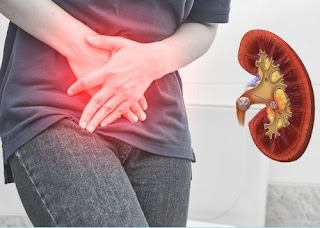 |
| Symptom of Vitamin D Toxicity |
There are some signs and symptoms of vitamin D toxicity, here we have mentioned 4 of them and described them.
1. Increases blood calcium levels
We know from research that vitamin D plays an important role in the absorption of calcium from food, high levels of vitamin D automatically lead to high levels of calcium in the body. In the body, the normal range for calcium is 8.5 to 10.8 mg/dL.
Symptoms of high calcium levels include digestive problems such as nausea, constipation, and abdominal pain. Other symptoms include hallucinations, dizziness, excess urination, loss of appetite, kidney stones, high blood pressure, heart failure, and dehydration.
In one case study, a boy developed abdominal pain and constipation after taking a mislabeled vitamin D supplement, while his brother's blood levels rose with no other symptoms.
2. Gastrointestinal symptoms
The main side effect of the presence of excess vitamin D levels is related to excessive calcium in the blood.
Nausea, Constipation, diarrhea, and Poor appetite are the main symptoms of hypercalcemia. But all people don't experience hypercalcemia with the same symptoms.
After taking a supplement one woman experienced nausea and weight loss that later contained 78 times more D vitamin than stated on the label.
To extremely high dose of vitamin D3 is responsible for occur these types of symptoms, where calcium levels are greater than 12 mg/dL.
In another case study, an 18-month-old child was given 50,000 IU of vitamin D3 for 3 months and the child experienced diarrhea, abdominal pain, and other symptoms. These symptoms resolve after the child stops taking the supplement.
3. Altered mental status
Since Hypercalcemia is a direct consequence of high levels of vitamin D, so it can lead to an altered mental state characterized by psychosis, confusion, and depression. Immediately you should consult with a doctor If you notice any of these symptoms.
4. Kidney complications
Excess intake of vitamin D can cause kidney damage or sometimes failure. Because high levels of vitamin D increase calcium levels, excess urine, and water loss due to kidney calcifications. As a result, the blood vessels in the kidneys become narrow and kidney function may decrease.
What is the treatment for vitamin D toxicity?
 |
| Treatment for Vitamin D Toxicity |
You should probably stop taking vitamin D supplements under your doctor's supervision. They will also limit how much calcium you get from food.
The doctor will give you fluids through a vein (IV) and you will also need to take medications such as steroids and bisphosphonates.
If your kidneys fail, you may need a treatment called hemodialysis. It takes over your kidneys' job of filtering water and waste from your blood.
Without serious health complications, most people recover themself from vitamin D toxicity, and they usually don't get it again.
How do you prevent vitamin D toxicity?
Before taking vitamin D supplements make sure you take the dose as prescribed by a doctor. And only buy supplements that are reliable and from licensed sources. Also, ask the doctor or pharmacist or check NSF's list of certified dietary supplements.
There are many vitamin D supplements available on the market, If you take one of these combo supplements, check the label to see how much D vitamin you're getting.
What is the Best Way to Take Vitamin D?
 |
| Best Way to Take Vitamin D |
Many people start taking this medicine without consulting a doctor to meet the deficiency of vitamin D in the body. However, we do not have a clear idea about the exact amount of vitamin D that can be consumed daily or the correct rules for taking this medicine.
In the normal process, 70% of the body's vitamin D deficiency is met by sunlight. To make the remaining 30 percent in the body, we need to keep vitamin D-rich foods in our diet.
If for some reason the production of vitamin D in the body is interrupted in this process, we should take vitamin D capsules according to the doctor's advice.
Experts say that if you start taking vitamin D without a doctor's advice, it may cause harm instead of benefits to the body.
Although, Vitamin D has many benefits. It helps in skin, hair, bones, and digestion in our body. So if you start taking only vitamin D the toxicity of it will see in the body. And vitamin D fails to do its job properly.
Researchers say that for the proper functioning of vitamin D in our body, vitamin K should be taken along with vitamin D. As a reason, they say, the proper functioning of vitamin D in the body depends on vitamin K.
In the presence of vitamin K, our body can absorb all the nutrients of vitamin D. But if vitamin K is deficient, the body cannot get the benefits of vitamin D by eating only vitamin D.
Another disadvantage of vitamin D is that the general public does not have many headaches about how much this drug can be taken or when to stop taking the drug.
However, the presence of excess vitamin D in the body is also dangerous. Taking too much vitamin D can cause problems with calcium accumulation in the blood that is greatly increase the risk of heart disease and stroke. Diseases like hyperkalemia may also occur.
This drug can be consumed in a maximum of 10 to 20 micrograms per day to avoid various complex diseases and to compensate for vitamin D deficiency in the body.
However, a low dose of vitamin K medicine must be taken with it. So it would be wise to start taking the medicines as per the advice of a doctor.
In the end, If there is excess vitamin D deficiency in the body, take vitamin D capsules as advised by the doctor.

إرسال تعليق